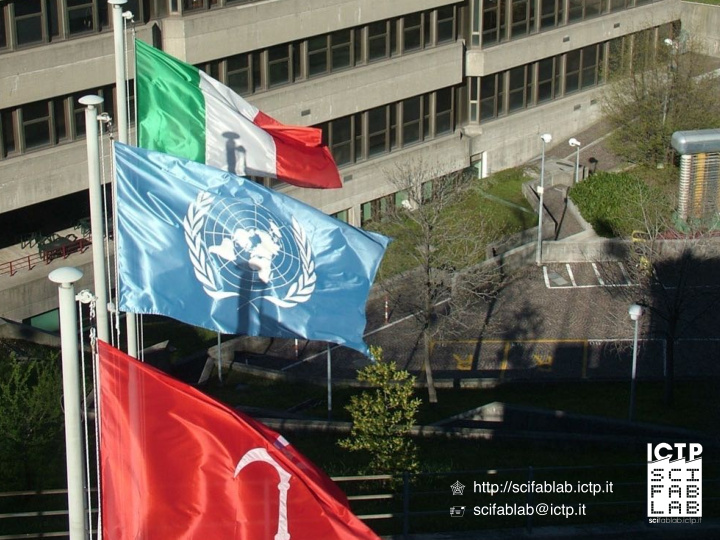



! http://scifablab.ictp.it " scifablab@ictp.it
Scientific Fabrication Laboratory since August 12, 2014
It's an academic idea... • The concept of a FabLab was first imagined at the Center for Bits and Atoms (CBA) at the Media Lab in the Massachusetts Institute of Technology, in 2001. • The paradigm was established in 2005 with The famous book by Neil Gershenfeld "Fab: the coming revolution on your desktop—from personal computers to personal fabrication".
CENTER FOR BITS AND ATOMS MIT MEDIA LAB
FAB, PAG. 23:
c FabLab = (d F x p ) Three key components • digital fabrication technologies • rapid prototyping • sharing of skills and experiences through Internet
1. THE MAKERS • At the very center of a FabLab are we, the people, the ones who make, the makers… • …out of curiosity, passion, sometimes also for work, but mainly because they like to make something with their own hands...
2. THE MACHINES • A computer-controlled lasercutter, for press-fit assembly of 3D structures from 2D parts • A larger (120x240cm) numerically- controlled milling machine, for making furniture- (and house-) sized parts • A signcutter, to produce printing masks, flexible circuits, and antennas • A precision (micron resolution) milling machine to make three-dimensional molds and surface-mount circuit boards • Programming tools for low-cost high- speed embedded processors http://fab.cba.mit.edu/about/faq/
3. THE PROCESSES • Prototyping : to make often , to make quickly , to make digitally • Digital technologies : by using open and standard formats, it’s easy to share ideas on the Net • Sharing : fostering the evolution of new/derived ideas, by “cascade effect” and by pervasive collaboration • Collaboration : the common working space of a fablab makes sharing experiences natural
4. THE NETWORK (OF FABLABS) • Fab Labs have to share a common set of tools and processes. A prototyping facility is not the equivalent of a Fab Lab. A 3D printer is not a Fab Lab. The idea is that all the labs can share knowledge, designs, and collaborate across international borders . If I make something here in Boston and s e n d y o u t h e fi l e s a n d documentation, you should be able to reproduce it there, fairly painlessly. If I walk into a Fab Lab in Russia, I should be able to do the same things that I can do in Nairobi, Cape Town, Delhi, Amsterdam or Boston Fab Labs
August 12, 2014 # August 25, 2017 then: the first (only) fablab in Friuli Venezia Giulia now: UD, PN, Maniago,… then: created after the first Trieste Mini Maker Faire now: starting point to create new ideas/activities…
Open to the public • Engagement of the local community of makers • ICTP mandate is to share knowledge • To attract young curious people to science • A gathering of scientists (have problems to solve, and little time/ money to learn new skills) and makers (passionate people looking for problems to solve, often with valuable technical skills)
People: how many? • Since the beginning (August 12, 2014) we hosted more than 100 projects • On average ~10 users present when the lab is open to the public (Tue, Thu & Sat: 3pm-9pm), open only to scientists on mornings • A network of ~80 external makers are connected with us (~20 are women) • A few ICTP visiting scientists worked here for weeks/months (Colombia, Cameroon, Nigeria) • A few International Workshops (2days - 2 weeks, ~30, hands-on) have been hosted here • A few students from University of Trieste and Udine did their thesis/working stages here
Trieste Mini Maker Faire 2014-2017 16000+ visitors 300+ makers ~100 booths all is OK ;-)
2014
2015
2016
2017
Thank You for Your Attention! ! http://scifablab.ictp.it " scifablab@ictp.it
Recommend
More recommend